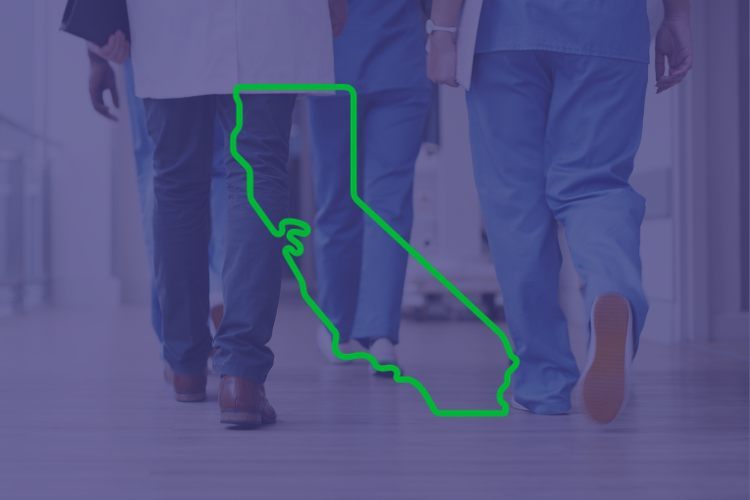California is known for being “extra,” and that’s what you can expect when it comes to medical credentialing services in California. The high volume of providers in California means both the credentialing and recredentialing processes are even longer.
Before looking specifically at provider credentialing in California, let’s start with a definition. Provider credentialing is a systematic, multi-step process that healthcare organizations and insurance networks use to verify and assess the qualifications of medical providers. The primary goal is to ensure that providers meet specific standards for professionalism, education, training, experience, and competency.
What’s Unique About Medical Credentialing in California
Here are some unique factors to consider regarding medical credentialing in the Golden State.
High Volume of Providers Causes Backlogs
There are so many healthcare providers in California that there are enrollment application backlogs. It can take as long as four to five months to credential a new provider simply because of this backlog. This lack of control can make it very stressful to handle medical credentialing in California.
Physical License Only
California currently provides physical licenses for practitioners. This wallet-size license requires holders to scan, photocopy, or take a picture for recredenialing or verification. The copies are often blurry and/or hard to read, making the credentialer’s job even more difficult.
Largest Payer Is an Integrated Health Care Delivery Organization
Kaiser Permanente has been one of California’s largest insurers for years. The organization is a non-profit with care and coverage as part of one organization. This is one less payer for many of the state’s credentialers.
Steps to Completing Provider Credentialing in California
Here are the general steps involved in completing medical credentialing in the state of California:
- Set Up Online Portals. Ensure the provider’s CAQH profile is up to date and if the provider will be enrolling with Medicare and the state’s Medicaid program, called Medi-Cal, set up those portals as well.
- Primary Source Verification. Primary source verification involves contacting original sources — such as educational institutions, licensing boards, and certification bodies — to confirm the authenticity and accuracy of the documents and qualifications provided by the provider. Payers in California have specific requirements.
- Work History and Reference Checks. To assess the provider’s experience and reputation within the healthcare community, the work history of the provider must be verified without any gaps longer than 30 days.
- Background Checks. Comprehensive background checks help rule out any criminal history, malpractice claims, disciplinary actions, or other records that might send up red flags.
- Payer Enrollment. Providers must be enrolled with every payer they accept insurance from — again, before they start seeing patients. With an average of 5 – 10 payers per provider, this can be a time-consuming and tedious step that needs to start early in the credentialing process.
- Privileging. Privileging involves the collection and review of a provider’s documentation to determine if they’re worthy to provide care to patients within a specific institution. All providers must receive privileges at the facility where they will see patients before they begin practicing.
Tips To Speed Up Credentialing in California
The time it takes to credential providers in California can vary depending on a variety of factors. Generally speaking, you should plan for several months at a minimum to complete the credentialing process from start to finish. The exact timeline depends heavily on the provider’s specialty, volume of providers, and the efficiency and completeness of the provider’s documentation.
- Start as soon as the provider is hired. Knowing that medical credentialing in California can take longer than usual, make sure you start collecting documents as soon as possible and, if enrolling with Medi-Cal, encourage the provider to set up a PAVE portal (Provider Application and Validation for Enrollment). Credentialing early will also alert you to any red flags or complications early in the hiring and onboarding process.
- Make it easy for providers to submit documents. It is much easier for you and the provider to request digital documents as opposed to collecting a paper credentialing packet. Credentialing software offers the ability for providers to securely submit documents to an online portal.
- Set a process specific to California’s payers. Payers, such as Blue Shield of California, all have specific requirements for the state in which they are located. Understanding this process and creating checklists for each payer will help you to complete medical credentialing in California much more quickly. A process (workflow) ensures continuity in case the credentialing expert is out of the office or has moved on.
- Set reminders and notifications. Because credentialing in California could take a while, it is especially important to schedule reminders for follow-ups. There’s likely to be a lot of back-and-forth in verifying information, so be sure to schedule reminders every time there’s an additional step required to complete the action. Credentialing software can automate these reminders to ensure you don’t miss steps or deadlines.

Get secrets to speed up your credentialing process.
Keep Credentialing Organized for California Providers
A long process, with some parts online and some on paper, makes medical credentialing in California a challenge. Using medical credentialing services in California can help to speed up the process because these credentialing specialists are used to the rules and regulations. In many cases, they have also developed good working relationships with the payers, which can smooth the process.
Find out how MedTrainer can help — whether you just need software or you’re looking for credentialing services to handle the process for you.
